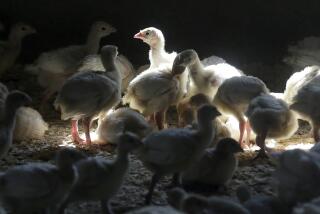A Chicken-and-Egg Problem: How to Speed Up Production of Flu Shots
If bird flu erupts into a pandemic, the world will need a lot of vaccine in a hurry. That would be virtually impossible with the current flu-vaccine manufacturing method, which is little changed since the 1940s.
Several companies have bird flu vaccines in development, though none is yet commercially available. Chiron Corp. of Emeryville, Calif., and Paris-based Sanofi-Aventis have begun clinical trials with vaccines that could be ready next year.
But flu vaccines traditionally are grown in millions of fertilized chicken eggs, a process that takes at least six months. The lengthy production cycle makes it hard for drug makers to keep up with mutating flu strains and limits the amount of vaccine they can produce quickly.
The egg-based method is particularly problematic for bird-flu vaccines because the disease threatens chickens, which provide the essential raw material.
So pharmaceutical companies are developing two methods — using cell cultures and DNA cloning — that could speed things up. But each faces hurdles in gaining official approval.
The best-known alternative is to grow vaccines in cell cultures, a decades-old technology already used for vaccines against chicken pox, hepatitis A and polio. Partly by removing the step of procuring huge stores of specially prepared eggs, it makes on-demand manufacturing possible.
Culturing flu vaccine strains using human, monkey or canine cells within sealed vats “can cut the production cycle to about four months, perhaps a little better,” while vastly increasing yield, said Lei Zhong, an analyst with Banc of America Securities who holds a doctoral degree in immunology.
Annual flu vaccine preparations begin in February and shots are ready in October. Cell culture vaccines could be available by July, and if a new flu strain suddenly emerged, an updated vaccine could be produced before the flu season peaked.
Chiron, Sanofi-Aventis and other companies have produced experimental cell-culture flu vaccines, and a European product may hit the market as early as next year, Zhong said.
But analysts said a U.S. product was still at least three years away because of more-demanding regulations.
Other vaccine makers and experts are putting faith in a second alternative to egg-based vaccines, one that involves a radical shift into genetic engineering.
Peter Dunnill, chairman of biochemical engineering at University College London, said DNA vaccine production, a technique invented a decade ago, eventually could yield 500 million doses of flu vaccine from a single lab in as little as three weeks and could cut the entire production cycle to three months.
PowderMed Ltd., a biotech in Oxford, England, and San Diego-based Vical Inc. have shown that DNA vaccines hold promise for fighting flu outbreaks.
DNA vaccines are far from proven, said Dr. Stanley Plotkin, an emeritus professor of pediatrics and microbiology at the University of Pennsylvania and consultant to Sanofi Pasteur, the vaccine unit of Sanofi Aventis. But animal studies show intriguing potential for stronger immunity and the prospect that one vaccine could confer a degree of immunity to a range of flu viruses.
PowderMed clones the gene for hemagglutinin, a protein on the surface of flu viruses, within the common lab bacterium E. coli. The flu DNA is purified, dried and coated onto microscopic specks of gold, forming a powder.
In clinical trials of an experimental vaccine for common flu with 36 subjects, the company’s vaccine worked well, with no serious side effects. The company said it would soon test a vaccine for H5N1, a bird flu strain.
Vical received a federal grant to develop a bird flu vaccine last month and hopes to advance to human trials with an experimental vaccine within two years.
The company plans to target the virus’ surface proteins as well as “conserved core proteins” — internal parts of the virus that are less changeable, said company spokesman Alan Engbring.
The approach could produce a vaccine that would still have some benefit as the flu virus mutated, or allow faster development of a new vaccine if H5N1 evolved into a pandemic strain, he said.
If large-scale trials succeed, the DNA method could offer some of the same advantages as the cell-culture method — with cost savings.
“The expense associated with DNA vaccines is much lower than with the other methods,” said Eric Schmid of SG Cowen Securities in New York.
The DNA and cell culture methods are also easier to keep clean than a factory full of eggs.
PowderMed knows the issue firsthand. In May 2003, Chiron Corp. agreed to buy British vaccine maker PowderJect Pharmaceuticals for about $878 million. A month later, PowderJect’s plant in Liverpool, England, was cited by regulators for contamination. It was the start of problems that led to the plant’s temporary closure last year and sparked a crisis in the U.S. flu vaccine supply.
Chiron spun off PowderMed last year, including executives and researchers at the original PowderJect, as a privately held company dedicated to producing powder-based vaccines. PowderMed has 36 employees and has raised $35 million in venture capital.
Another advantage of DNA vaccines is that they can be given without a needle. PowderMed uses a painless “gene gun” — much like the device used by Dr. McCoy on the TV series “Star Trek.” A high-speed puff of compressed helium implants the gold powder into the skin. The devices are so easy to use that the company plans to train grocery clerks to give vaccines.
Nevertheless, DNA vaccines are running well behind cell-culture methods in the competition to replace egg-based methods of flu vaccine production, said Aaron Geist, an analyst with Robert W. Baird & Co. who has a doctorate in microbiology and virology.
“The standard manufacturing capacity of cell culture has been proven in the biotechnology market,” Geist said. “We have yet to see the feasibility of DNA vaccines in scientific studies to determine if or when they will hit the commercial market.”
Dr. Gary Nabel, director of vaccine research for the National Institute of Allergy and Infectious Diseases, compared egg-based manufacturing to the traditional QWERTY typing keyboard layout — awkward and inefficient, yet so widely used that moving to a new method would be staggeringly hard.
So for the time being manufacturers will try to increase egg-based vaccine efficiency with “adjuvants” — chemical additives that boost immune response so that a lower dose has the same benefit. Chiron reported positive results Friday for early trials of an experimental adjuvant vaccine for H9N2, another common bird flu virus that can infect humans.
“We like DNA vaccines because they are so simple,” Nabel said, noting that his agency funds more than $30 million in DNA vaccine research for several diseases. “But it’s not quite ready for prime time.”Nabel also cautioned against being seduced by what seemed at first like a miracle solution.In 1976, swine flu virus was mistakenly seen as a pandemic strain. The government rushed a vaccine into circulation that was later believed to have caused hundreds of cases of Guillain-Barre syndrome, a rare paralytic disorder.
“The ghost of swine flu is out there,” Nabel said. “We’re trying to balance the risk of the pandemic, the risk of the vaccine not working, the risk of side effects.”
Such cases led to stringent regulations that increase safety but delay promising strategies. Given low profit margins in the vaccine business, few drug companies can justify the long-term risk.
“You’re talking about a billion-dollar project for not a very high-profit product,” said Dr. Paul Offit, a vaccine expert at Children’s Hospital of Philadelphia.
Despite the obstacles, one fact remains: With egg-based manufacturing methods, if pandemic flu strikes, the supply of vaccine would run out virtually overnight.
Offit and others have called for urgent action on all fronts.
Nabel endorsed the concept.
“In three to five years we’ll say we finally stared this problem in the face and found the solution,” he said. “DNA would be part of it.”
*
BEGIN TEXT OF INFOBOX
A faster way?
A new DNA technology may produce more flu vaccine more quickly than the traditional method, which uses chicken eggs.
Traditional method
Samples of flu strains are injected into millions of eggs, where the viruses multiply. The viruses are harvested from the egg whites and killed to produce flu shots. The production process takes at least six months.
DNA vaccines
1. A tiny section of the genetic material of the flu virus is patched into a circular piece of DNA called a plasmid.
2. The plasmid is cloned within bacteria, creating many copies of the viral DNA.
3. The flu DNA is purified, dried and coated onto microscopic gold particles, forming a powder.
4. A “gene gun” uses compressed helium to painlessly implant the vaccine powder into the skin.
The production process would take about three months.
Sources: PowderMed, Times reporting
More to Read
Inside the business of entertainment
The Wide Shot brings you news, analysis and insights on everything from streaming wars to production — and what it all means for the future.
You may occasionally receive promotional content from the Los Angeles Times.










